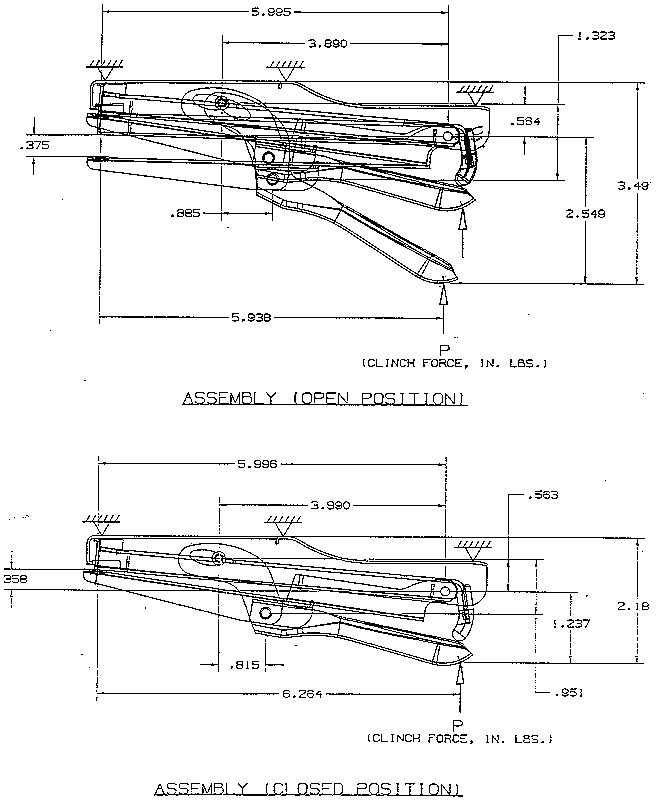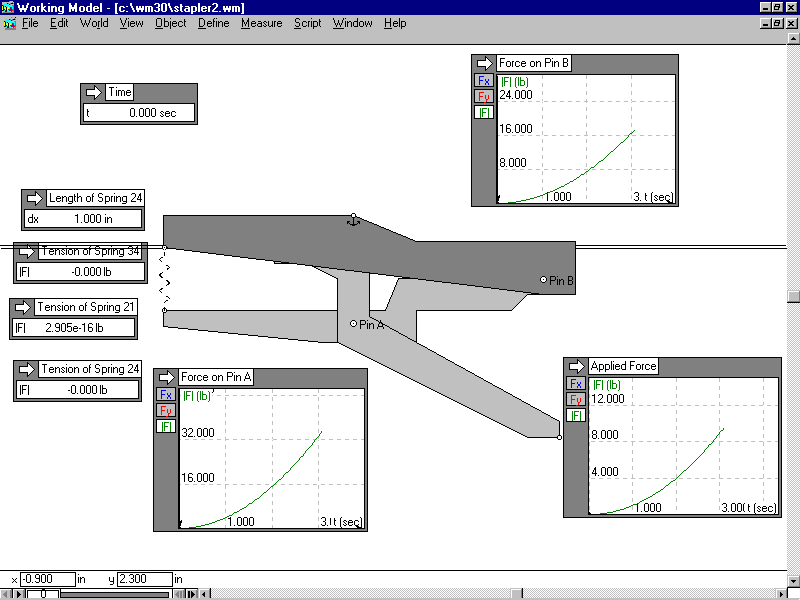![]()
![]()

Objectives:
Develop a simulation of a Stanley Bostich stapler. Model the non-linear
load deflection behavior associated with penetrating a stack of paper followed
by crimping of the staple. Determine the forces transmitted through the
pins and the mechanical advantage of the device
Instructional Objectives:
Develop Working Model tools including the polygon tool (using the Geometry
window to edit coordinates of the vertices), pins, slots, springs (connected
in parallel to simulate a non-linear spring force), vector display and
output meters.
Background:
In developing a mechanical device such as a stapler for a particular
application, designers must consider both functionality and performance.
The stapler must be designed to provide adequate mechanical advantage to
allow for stapling of a given thickness of stacked paper. The stapler must
be designed to perform reliably under repeated uses over a long period
of time. Hence, the designer must be able to determine both the forces
transmitted through the stapler and the mechanical advantage for various
configurations in order to identify an optimal design.
Working Model provides an excellent simulation of the operation of devices such as staplers. By providing animation of the stapler operation and computing the forces transmitted through the device, various designs can be created and evaluated easily and quickly. Through this process of "Virtual Prototyping", new designs can be brought to market very quickly and as a result, can have a significant impact on a manufacturer's productivity.
Assignment:
In this assignment, you are asked to develop a simulation of the stapler
shown in Figure 1. The simulation models the stapler using three polygons,
the dimensions of which are given in Figures 2, 3 and 4. Note that while
the polygon dimensions approximate the shape of the stapler, it is the
locations of the pins , force application point and springs connections
(Figures 5 and 6) which determine the force solutions we are seeking. Hence,
these points are created to exactly match the actual stapler dimensions.
In the actual device, Pin C on the "middle" member slides in
a curved slot in the "top" member. Since Working Model does not
provide the capability to attach slots to bodies, we can model this mechanism
by anchoring the "top" member (using the anchor tool) and connecting
the Pin C in the middle member to a horizontal slot (which is attached
to the background).
The load deformation response of the staple penetrating the paper followed by crimping is shown in Figure 7. To model this non-linear response, we create three springs in parallel. These springs have spring constants given by 4, 11, and 45 lb/in initial lengths of 1, 0.5, and 0.3 in, respectively. Also, we must require that these springs are active only when their lengths are less than the initial lengths. All of these spring parameters are entered in the spring properties windows (Figure 8). Finally, a vertical force is applied at the handle. To simulate the entire range of motion, this force should be ramped slowly (to assure quasi-static conditions) from zero. This is done by entering an equation in the force properties window.
To be turned in:

Figure 1. Dimensions of the stapler to be analyzed

Figure 2. Dimensions of the "top" member

Figure 3. Dimensions of the "middle" member

Figure 4. Dimensions of the "bottom" member

Figure 5. Location of the pin connections

Figure 6. Assembled model showing pin slot and output windows

Figure 7. Load deflection response during stapling

Figure 8. Parameters for the three springs connected in parallel